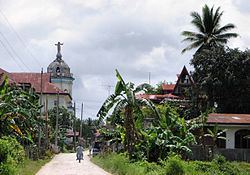Country Philippines Founded 17 March 1876 Time zone PST (UTC+8) Local time Sunday 4:46 PM Team BM Antequera | District 1st district of Bohol Barangay Area 118.6 km² Province Bohol | |
 | ||
Region Central Visayas (Region VII) Weather 24°C, Wind N at 13 km/h, 90% Humidity | ||
Mag aso falls antequera bohol philippines
Antequera is a 4th municipal income class municipality in the province of Bohol, Philippines, at 18 kilometres (11 mi) north of Tagbilaran. According to the 2015 census, it has a population of 14,425. In the 2016 electoral roll, it had 8,691 registered voters.
Contents
- Mag aso falls antequera bohol philippines
- Map of Antequera Bohol Philippines
- Weekend aerials maribojoc antequera bohol philippines
- History
- Barangays
- Demographics
- Economy
- References
Map of Antequera, Bohol, Philippines
Popular places of interest in Antequera are the weekly basket market and Mag-Aso Falls. The Mag-Aso falls, whose cascading waters run into natural pools, were greatly altered by the 2013 Bohol earthquake and even more so by flash floods caused by Tropical Storm Seniang in December 2014.
Weekend aerials maribojoc antequera bohol philippines
History
The early inhabitants of the area were the Eskaya people, who lived in western Bohol, including the lowlands of Antequera at the present barangay of Viga, from the 7th century until the early 17th century. One legendary Eskaya leader was King Lomod or Tamblot, who raised a revolt against the Spanish conquistadors.
Originally the town was a barangay of Maribojoc known as Agad. Migration from surrounding coastal areas increased the population and created many new sitios. On 17 March 1876, the Governor-General of the Philippines signed a decree that made Agad and all its sitios a new municipality. That same year, the governor of the District of Bohol, Joaquin Bengoechia, enacted the law that finalized the boundaries and appointed its first mayor, Simeon Villas. The new municipality was named after the home town in Spain of Bengoechia.
In 1899, the town of Catigbian was abolished, and the barangays of Caimbang, San Isidro, and Causwagan were added to Antequera. But it lost these barangays, along with half of Cansague, when Catigbian was reestablished on 17 June 1949. On 10 January 1970, the municipality of San Isidro was formed, taking the barangays of Cambansag, Abehilan, and Baunos from Antequera.
Barangays
Antequera comprises 21 barangays:
Demographics
In the 2016 electoral roll, it had 8,691 registered voters, meaning that 60% of the population are aged 18 and over.
Economy
The primary economic activities are farming, handicraft or cottage industries (especially basket weaving), and carpentry (including bamboo and wood furniture making). Its main agricultural produce comprises coconut, rice, corn, rootcrops, and vegetables.
Total annual income in 2010 was ₱35,960,730
